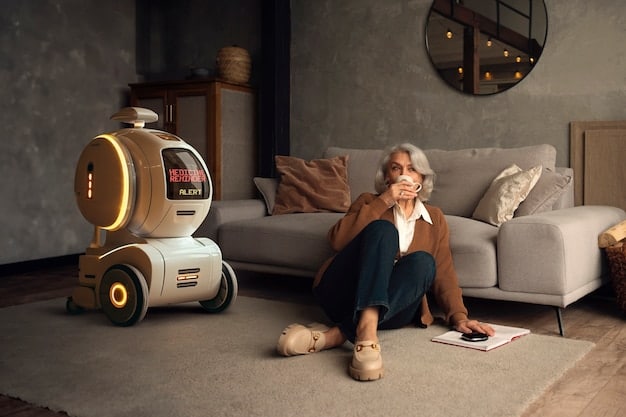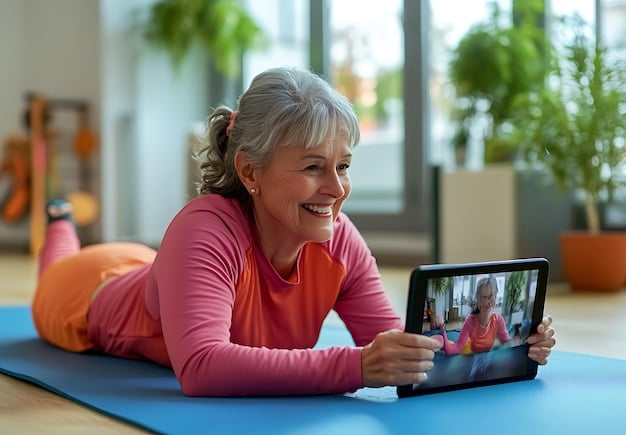The Future of Caregiving: Trends & Tech to Watch in 2025

The Future of Caregiving: Emerging Trends and Technologies to Watch in 2025 involves a shift towards personalized care, leveraging technologies like AI and telehealth, and addressing the increasing demand for skilled caregivers in a rapidly aging population, making support more accessible and efficient for both caregivers and care recipients.
The landscape of caregiving is rapidly evolving, driven by technological advancements and changing demographic trends. Let’s explore the future of caregiving: emerging trends and technologies to watch in 2025, and how they’ll reshape support for both caregivers and those in need.
The Rise of Gerontechnology
Gerontechnology, the intersection of technology and gerontology, is becoming increasingly vital in reshaping the future of caregiving. It aims to enhance the independence, health, and safety of older adults through technological interventions.
Wearable Health Monitors
Wearable devices are evolving beyond simple fitness trackers. They now offer comprehensive health monitoring, from heart rate and sleep patterns to fall detection and medication reminders.
Smart Home Systems
Smart homes are becoming more adaptive to the needs of seniors, featuring voice-controlled lighting, automated temperature settings, and safety features like stove shut-off systems.

- Remote monitoring capabilities allow caregivers and healthcare providers to track vital signs and respond quickly to emergencies.
- Personalized alerts and reminders help seniors maintain their medication schedules and daily routines.
- Data-driven insights enable proactive interventions, improving overall health outcomes and reducing hospital readmissions.
The integration of gerontechnology offers solutions for aging populations and streamlines caregiving responsibilities, making it possible for seniors to remain independent and comfortable in their own homes.
Artificial Intelligence (AI) in Caregiving
AI is poised to revolutionize caregiving by providing personalized support, automating repetitive tasks, and offering companionship to seniors. Its applications range from virtual assistants to robotic companions, all designed to enhance the quality of life for both caregivers and care recipients.
AI-Powered Virtual Assistants
Virtual assistants, like Amazon’s Alexa and Google Assistant, can be customized to support seniors with medication reminders, appointment scheduling, and access to emergency services.
Robotic Companionship
Robotic pets and companion robots provide emotional support and social interaction, reducing feelings of loneliness and isolation among older adults.
- AI algorithms analyze health data to provide personalized recommendations for diet, exercise, and mental well-being.
- Machine learning enhances the accuracy and efficiency of predictive healthcare, allowing for early intervention in potential health crises.
- AI-driven tools automate administrative tasks, allowing caregivers to focus on providing compassionate, hands-on care.
The integration of AI into caregiving aims to alleviate the burdens of care, allowing for more personalized and effective care strategies that cater to the individual needs of aging populations.
Telehealth and Remote Monitoring
Telehealth and remote monitoring are transforming healthcare delivery, making it easier for seniors to access medical services from the comfort of their homes. These technologies reduce the need for frequent in-person visits, improving the convenience and affordability of care.

Virtual Doctor Visits
Telehealth platforms enable seniors to consult with healthcare providers remotely, discussing their health concerns and receiving medical advice without traveling to a clinic.
Remote Patient Monitoring (RPM)
RPM devices track vital signs and health metrics, transmitting data to healthcare providers who can monitor patients’ conditions and intervene as needed.
- Telehealth reduces the risk of exposure to infectious diseases, particularly beneficial for seniors with compromised immune systems.
- RPM systems improve medication adherence by providing real-time feedback and alerts to both patients and caregivers.
- Telehealth and RPM enhance the efficiency of healthcare delivery, allowing providers to manage a larger patient population with limited resources.
Telehealth and remote monitoring offer convenient and effective ways to manage health conditions, empowering seniors to take control of their well-being while reducing the strain on healthcare resources.
Personalized Care Plans
Personalized care plans are essential for addressing the unique needs and preferences of each care recipient. These plans take into account individual health conditions, lifestyle, and cultural background to deliver tailored support.
Customized Activity Programs
Care plans include activities that promote cognitive stimulation, physical exercise, and social engagement, tailored to the individual’s interests and abilities.
Nutritional Support
Personalized meal plans and dietary recommendations ensure that seniors receive the nutrients they need to maintain their health and well-being.
Care plans adapt to changing needs, providing a mechanism for ongoing assessment and adjustment to ensure care remains effective and relevant.
Individualized care is crucial for elderly individuals; it enhances their overall quality of life with attention to both their physical and mental health.
The Role of Robotics in Physical Assistance
Robotics is becoming an integral part of providing physical assistance to seniors, helping them with mobility, daily tasks, and rehabilitation. These robots are designed to augment human capabilities, offering support and companionship.
Exoskeletons for Enhanced Mobility
Exoskeletons provide support for seniors with mobility issues, enabling them to walk, climb stairs, and perform other physical activities with greater ease.
Robotic Assistants for Daily Tasks
Robotic arms and automated assistants help seniors with tasks such as cooking, cleaning, and personal hygiene, promoting independence and reducing reliance on caregivers.
- Robotic rehabilitation devices assist seniors in regaining strength and motor skills after injuries or illnesses.
- Robots ensure precision and consistency, improving the effectiveness of therapeutic exercises and rehabilitation programs.
- Robotics reduces the physical strain on caregivers, lowering the risk of workplace injuries and burnout.
The integration of robotics into caregiving offers innovative solutions for physical assistance, empowering seniors to maintain active and fulfilling lives while minimizing the burdens on caregivers.
Addressing the Caregiver Shortage
The demand for caregivers is growing rapidly, driven by an aging population and increasing rates of chronic diseases. Addressing the caregiver shortage requires innovative solutions, including technology-driven support, policy changes, and increased training opportunities.
Technology Training for Caregivers
Training programs equip caregivers with the skills to use new technologies, such as telehealth platforms and remote monitoring devices, enhancing their ability to provide effective care.
Respite Care Programs
Respite care provides temporary relief to family caregivers, allowing them to take breaks and recharge, reducing the risk of burnout.
- Policy initiatives support the recruitment and retention of caregivers, offering competitive wages, benefits, and career advancement opportunities.
- Financial incentives, such as tax credits and subsidies, alleviate the financial burden on family caregivers, recognizing the valuable role they play in the healthcare system.
- Public awareness campaigns promote the value of caregiving as a profession, encouraging more individuals to pursue careers in this field.
Addressing the caregiver shortage requires a multifaceted approach that leverages technology, policy, and community support, ensuring that seniors receive the care they need while supporting the well-being of their caregivers.
| Key Point | Brief Description |
|---|---|
| 🤖 Robotic Assistance | Robots assist with mobility and daily tasks, enhancing independence. |
| 📱 Telehealth | Remote medical consultations offer convenient healthcare access. |
| 🧠 AI Support | AI provides personalized health recommendations and virtual assistance. |
| 🏡 Smart Homes | Automated systems enhance safety and independence for seniors. |
Frequently Asked Questions (FAQs)
▼
AI is expected to provide more personalized and efficient care through virtual assistants and data-driven health insights, helping caregivers better manage their responsibilities and improving care recipients’ well-being.
▼
Telehealth offers convenient access to medical consultations, reduces travel time, minimizes the risk of exposure to infections, and enhances remote monitoring capabilities for timely interventions.
▼
Smart home devices automate tasks, improve safety through fall detection systems, and provide voice-controlled assistance, enabling seniors to maintain independence and live comfortably in their homes.
▼
Personalized care plans address the unique needs of each individual; include tailored activities and nutritional support; and ensure high-quality, effective care is matched with personal health goals.
▼
Exoskeletons provide support to seniors with limited mobility, enabling them to walk, climb stairs, and perform daily tasks with greater ease, promoting physical activity and reducing the risk of falls.
Conclusion
As we look towards 2025, the future of caregiving: emerging trends and technologies to watch in 2025 reveals a landscape shaped by technology, enabling more personalized, efficient, and accessible care. By embracing AI, telehealth, robotics, and smart home solutions, we can create a future where seniors receive the support they need to thrive, and caregivers are empowered to provide the best possible care.





